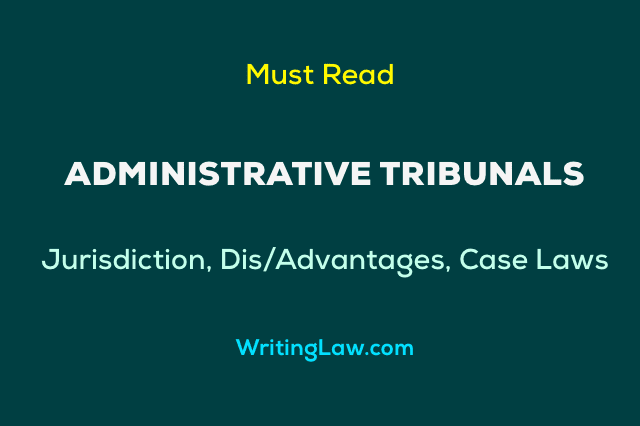
What is an Administrative Tribunal?
With respect to administrative law, tribunals are referred to as those bodies that have quasi-judicial power (not similar to court procedures). They are not like the sub-ordinate courts or superior courts. Quasi-judicial authorities are established under an act of Parliament or of the state legislature to discharge adjudicatory functions.
Our courts are overcrowded with numerous cases. Therefore, for speedy and effective justice, part of the judicial power is delegated to the tribunals.
Notes:
- The first tribunal that existed before independence was the Income Tax Appellate Tribunal.
- High Courts have jurisdiction over administrative tribunals under Article 226, and it may exclude the jurisdiction of all courts even under Article 226/227 except Special Leave Petition under Article 136.
- The Finance Act of 2017 merged eight tribunals w.r.t the similarity in its functions.
Now let us learn more about administrative tribunals in easy-to-understand words.
- What is an Administrative Tribunal
- Indian Precedent
- Areas where tribunals have no jurisdiction
- Case Laws related to Administrative Tribunals
- Advantages of Administrative Tribunals
- Disadvantages of Administrative Tribunals
- Bottle-necks faced by Administrative Tribunals
Indian Precedent
Our Constitution did not have provisions for administrative tribunals. The Swaran Singh Committee had referred to the creation of administrative tribunals, which resulted in the 42nd amendment of the Constitution of India, which inserted Article 323A (tribunals for administrative cases, for example, public service matters) and Article 323B (tribunals for other matters. example, tax, foreign matters, food-stuff, rent etc.) into Part XIV-A with the primary objective being efficacious remedy and speedy justice in certain cases.
After the amendment of the Constitution, the Parliament passed the Administrative Tribunals Act of 1985, which empowered the government to create central administrative tribunals and state administrative tribunals.
Note: The President of India officially promulgated an ordinance named Tribunals Reforms (Rationalisation and Conditions of Service 2021) on 4th April 2021, which took away the appealing power of certain authorities and conferred the same to High Courts, which are briefed below. The names of the Act are:
- Cinematograph Act
- Copyright Act, 1957
- Customs Act, 1962
- Patents Act, 1970
- Airports Authority of India Act, 1994
- Trade Marks Act, 1999
- Geographical Indication of Goods Act, 1999
- Protection of Plant Varieties and Farmers Rights Act, 2001
- Control of National Highways Act, 2002
- Finance Act, 2017
Areas where tribunals have no jurisdiction
These are the areas where administrative tribunals have no jurisdiction:
- Members of the Union’s Armed Forces.
- Staff & Members of Judiciary.
- Members of Secretarial Staff of State and Central Legislature.
Case Laws related to Administrative Tribunals
Sampath Kumar vs Union of India: Powers of the tribunal are similar to that of a High Court.
Union of India vs Deep Chand Pandey: In the presence of an administrative tribunal, the High Court does not have the power to deal with cases.
Chandra Kumar vs Union of India: The judicial review power of the tribunals, which was taken away, was nullified.
Note: Only two writs, namely certiorari and prohibition, are available against the order of the administrative tribunal.
Advantages of Administrative Tribunals
The four main advantages of administrative tribunals are:
- Flexible (Adaptable to different situations).
- Efficacy and Speedy Justice.
- Cheaper and Simplified Procedures.
- Relief for courts.
Disadvantages of Administrative Tribunals
The four main disadvantages of administrative tribunals are:
- Separate procedures are followed, which deviate from the rule of law.
- Even though tribunals have similar power to courts, they don’t enjoy the same amount of independence.
- No statutory procedures are available as followed by subordinate and higher courts.
- The staff of administrative tribunals are experts in specific fields, but due to a lack of judicial knowledge, quicker procedures are being followed to deal with cases.
Bottle-necks faced by Administrative Tribunals
- Insufficient infrastructure.
- They are dependent on the executive for funds.
- Insufficient staff.
Conclusion: The executive should take steps to uplift the tribunals for proper functioning and reduce the burden on the judiciary. Time has demanded that tribunals be reformed for their efficient functioning.
Read Next:
1. What Is the National Green Tribunal
2. What Is the Central Administrative Tribunal
- 10 Types or Kinds of Jurisdiction of Indian Courts - 13th April 2022
- Malicious Charge of Offence Under Section 211 of the Indian Penal Code - 17th March 2022
- About Supreme Court of India – Collegium, Powers, Judges - 7th February 2022







